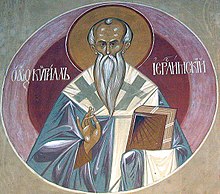Cyril of Jerusalem
| Saint Cyril of Jerusalem | |
|---|---|
 |
|
| Bishop, Confessor and Doctor of the Church | |
| Born | c. 313 AD possibly near Caesarea Maritima, Syria Palaestina (Modern-day Israel) |
| Died | 386 AD (aged 73) Jerusalem, Syria Palaestina |
| Venerated in |
Eastern Orthodox Church Oriental Orthodoxy Roman Catholic Church Anglican Communion Lutheran Church |
Cyril of Jerusalem (Greek: Κύριλλος Α΄ Ἱεροσολύμων, Kýrillos A Ierosolýmon; Latin: Cyrillus Hierosolymitanus) was a distinguished theologian of the early Church (c. 313 – 386 AD). He is venerated as a saint by the Roman Catholic Church, the Eastern Orthodox Church, and the Anglican Communion. In 1883, Cyril was declared a Doctor of the Church by Pope Leo XIII. He is highly respected in the Palestinian Christian Community.
About the end of 350 AD he succeeded Maximus as Bishop of Jerusalem, but was exiled on more than one occasion due to the enmity of Acacius of Caesarea, and the policies of various emperors. Cyril left important writings documenting the instruction of catechumens and the order of the Liturgy in his day.
Little is known of his life before he became a bishop; the assignment of his birth to the year 315 rests on conjecture. According to Butler, Cyril was born at or near the city of Jerusalem, and was apparently well-read in both the Church fathers and the pagan philosophers.
Cyril was ordained a deacon by Bishop St. Macarius of Jerusalem in about 335 and a priest some eight years later by Bishop St. Maximus. About the end of 350 he succeeded St. Maximus in the See of Jerusalem.
Relations between Metropolitan Acacius of Caesarea and Cyril became strained. Acacius is presented as a leading Arian by the orthodox historians, and his opposition to Cyril in the 350s is attributed by these writers to this. Sozomen also suggests that the tension may have been increased by Acacius's jealousy of the importance assigned to St. Cyril's See by the Council of Nicaea, as well as by the threat posed to Caesarea by the rising influence of the see of Jerusalem as it developed into the prime Christian holy place and became a centre of pilgrimage.
...
Wikipedia
